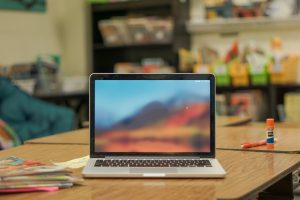TL;DR:
- To make sure we avoid tech burnout, we need to rethink how many ed-tech tools we use. And we need to refocus on how we deploy ed-tech to address problems.
- Pick ed-tech tools that help you do your job better, that make teaching and learning more fun, and are engaging.
- Shift your focus to what will be easiest for the users (students, parents/guardians) to use!
- We can spend less time teaching HOW to use a tool and more time supporting students as they create.
I love ed-tech. I have spent untold hours learning new tools, crafting tech-driven lessons and units, and modeling tools for other teachers. Ed-tech made me a better teacher and helped me support all learners. As much as I love ed-tech, lately I’ve been worried: In the wake of hybrid and distance learning, we run the risk of tech burnout, for both teachers and students (not to mention parents/guardians).
So how do we ensure that as things “return to normal,” ed-tech burnout doesn’t lead to less ed-tech? For me, it requires a one-two punch:
- Rethink how many ed-tech tools we use.
- Refocus on how we deploy ed-tech to address problems.

Rethink and Reduce Tech Tools
We all have opinions, favorites, staples. It’s hard to let go of what you’re used to, what you love, what you’ve used to create lots of content. I had my go-to tools.
But when my school adopted Schoology, I transferred all my online quizzes and activities to Schoology. A Google lover, when I moved to a school that provided Microsoft accounts for all students and teachers, I switched. Why? It was easier for students (and the parents/guardians supporting their learning at home).
As much as I love ed-tech, lately I’ve been worried: In the wake of hybrid and distance learning, we run the risk of tech burnout, for both teachers and students. Share on XWhat does this look like?
When possible, work with colleagues to choose which apps, platforms, and systems everyone will use. It’s just like scaffolding curriculum, but with tech. Rather than expecting students (and parents/guardians) to learn NearPod for one class and then PearDeck for another, pick one. Instead of Seesaw one year then Class Dojo the next, try to be consistent.
Yes, that might mean YOU have to learn a different tool or have to ditch a long-loved favorite. But by shifting our focus to what will be easiest for our users* (students, parents/guardians) we’ll be creating less work for ourselves in the long run. We can spend less time teaching HOW to use a tool and more time supporting students as they create. Plus, as students use a tool more and more, their skill with that tool increases. As their skill increases, so, too, does the likelihood that we are evaluating their content mastery, not their tech tool mastery.
*This doesn’t mean never using new or unique tools. There is value in helping students—particularly older students—learn how to apply and adapt a set of skills to a new tool. Just be aware of what kids already know and prefer to use. Then make informed decisions on when to introduce new tools. As a high school teacher, whenever possible, I give students the option to use any tool that gets the job done and fulfills the learning requirements; they just know that I may not be able to help them troubleshoot issues.
[scroll down to keep reading]Refocus on Ed-Tech to Tackle Problems
You likely already do this: Pick ed-tech tools that help you do your job better, that make teaching and learning more fun, and are engaging. Let’s take it a step further by taking a step back.
What does this look like?
Start by reflecting on the past year: What got in the way of teaching? Of learning? What ed-tech tools caused problems? Which tools increased engagement and joy? Brainstorm and make a few lists. Most importantly: ASK YOUR STUDENTS! Their experiences will provide invaluable information as you aim for better ed-tech.
Now assess: As you look at your list of challenges and learning obstacles, what challenges might be addressed or reduced by ed-tech? Consider tools you already use; could any play double-duty and be creatively deployed to solve a challenge? Again, don’t be afraid to ASK. Ask students what they enjoy using. Ask colleagues what tools they’ve had success with. Reach out to a few tech gurus—both in-house and online—to gather the best options.
Finally, strategize: With your problem in mind, outline how you will integrate and utilize your chosen ed-tech tool(s). When you start with the problem or challenge in mind, HOW you deploy the ed-tech will shift and become more focused. This increases the likelihood the tool will actually help address the problem and make ed-tech more meaningful for you and students.
Help prevent tech burnout—for students, parents/guardians, and yourself—while increasing ed-tech’s impact. A bit more strategy and work upfront can lead to a lot more impact in the long run.
About Darcy Bakkegard
Darcy Bakkegard is an English/Theatre teacher who got tired of traditional sit-n-get PD and now creates the type of PD she always wanted with The Educators’ Lab. With 10 years of experience teaching English and Theatre, Darcy specializes in interactive strategies for the classroom, meaningful tech integration, and building relationships with students. Darcy is an ISTE Certified Educator, an experienced international presenter, and empowerer of teachers. She co-authored The Startup Teacher Playbook to help teachers take back their professional development and rekindle their spark for teaching.



